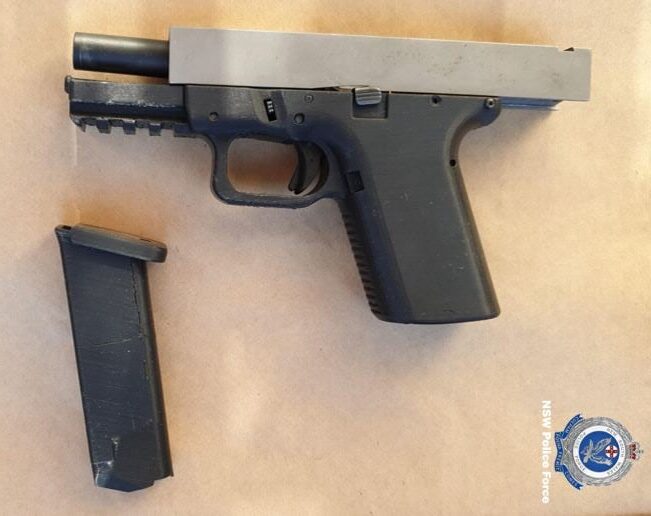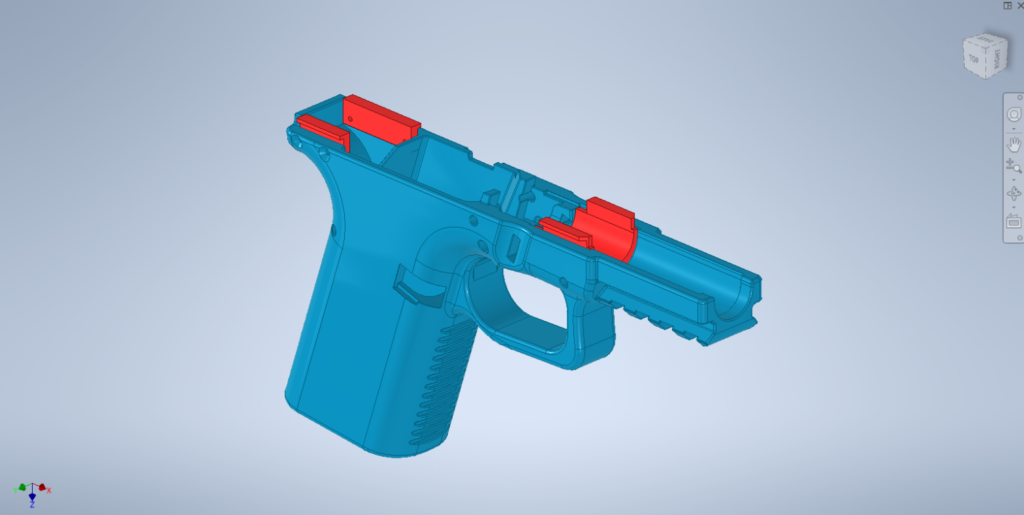G. Hays & N.R. Jenzen-Jones
The New South Wales Police force have charged a 32-year-old man in Sydney, Australia with firearms offences following a raid on a Newtown home on 22 September 2020. During the raid, a Glock-type self-loading pistol assembled using some 3D-printed components was seized along with a 3D printer, additional 3D-printed firearm parts, ammunition, electronic devices, and cannabis. The pistol appears to be assembled from a combination of 3D-printed components and purpose-made components imported illegally from the United States.

Weapons assembled from a combination of purpose-made and 3D-printed components in this way are known as a ‘parts kit conversion’ or ‘parts kit completion’ (PKC) builds. Typically, the slide, barrel, and trigger components are of commercial origin, whilst the frame (or ‘receiver’) is produced using a 3D printer. PKC designs are generally favoured where commercial parts can be readily acquired, but complete firearms—or key components, such as the frame or receiver—are legally controlled. In the Australian case, the use of 3D-printed components manufactured by individuals inside Australia reduces the number of components that need to be illicitly imported, probably reducing the likelihood of detection. To the non-specialist, such PKC firearms may appear to be factory-made or perhaps modified examples of commercially available products, implying they would be accessed through traditional criminal networks and black markets. In fact, such weapons are often indicative of criminal users employing alternative methods to acquire firearms.

The 3D-printed frame in this case is readily identifiable by striations on the frame (known as ‘layer lines’) which indicate that the frame was printed with its top down to the printbed. The presence of screw holes at the rear of the design, not present on a purpose-made Glock receiver is another tell-tale identification feature. These frame designs incorporate craft-produced internal rails modelled after those of the Glock 19, which serve to guide the slide as it reciprocates (see Figure 1.2). Two screws are typically used to hold these (likely aluminium) rails in place. The slide is not an OEM (Glock) component, instead being a cheaper design often marketed to producers of so-called ‘80%’ kits and frequently used by individuals producing PKC firearms. The printable FMDA G19 receiver as well as the ‘Mini-Menendez’ magazine also seized were both released as digital files last year by an online group of 3D-printed firearms developers known as Deterrence Dispensed.
A number of 3D-printed handguns were seized by NSW Police just last month, and entirely or partially 3D-printed firearms are increasingly being used by criminals in Australia, the United States, Canada, and elsewhere around the world.

The production of 3D-printed pistol frames, and the nature of PKC builds more generally, is discussed in ARES Research Report No. 8, Desktop Firearms: Emergent Small Arms Craft Production Technologies.
Remember, all arms and munitions are dangerous. Treat all firearms as if they are loaded, and all munitions as if they are live, until you have personally confirmed otherwise. If you do not have specialist knowledge, never assume that arms or munitions are safe to handle until they have been inspected by a subject matter specialist. You should not approach, handle, move, operate, or modify arms and munitions unless explicitly trained to do so. If you encounter any unexploded ordnance (UXO) or explosive remnants of war (ERW), always remember the ‘ARMS’ acronym:
AVOID the area
RECORD all relevant information
MARK the area from a safe distance to warn others
SEEK assistance from the relevant authorities


3 thoughts on “PKC Glock with 3D-printed frame seized in Sydney, Australia”